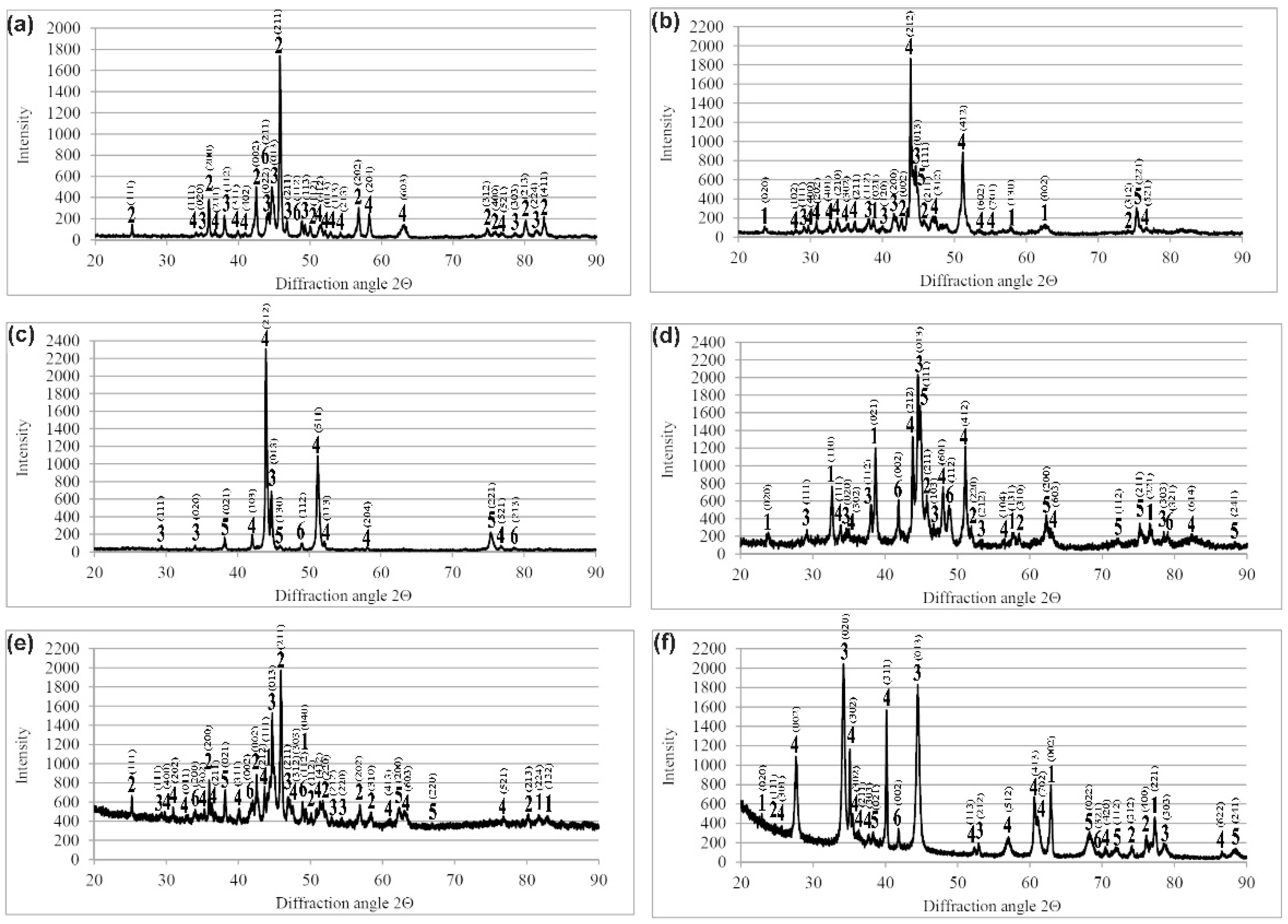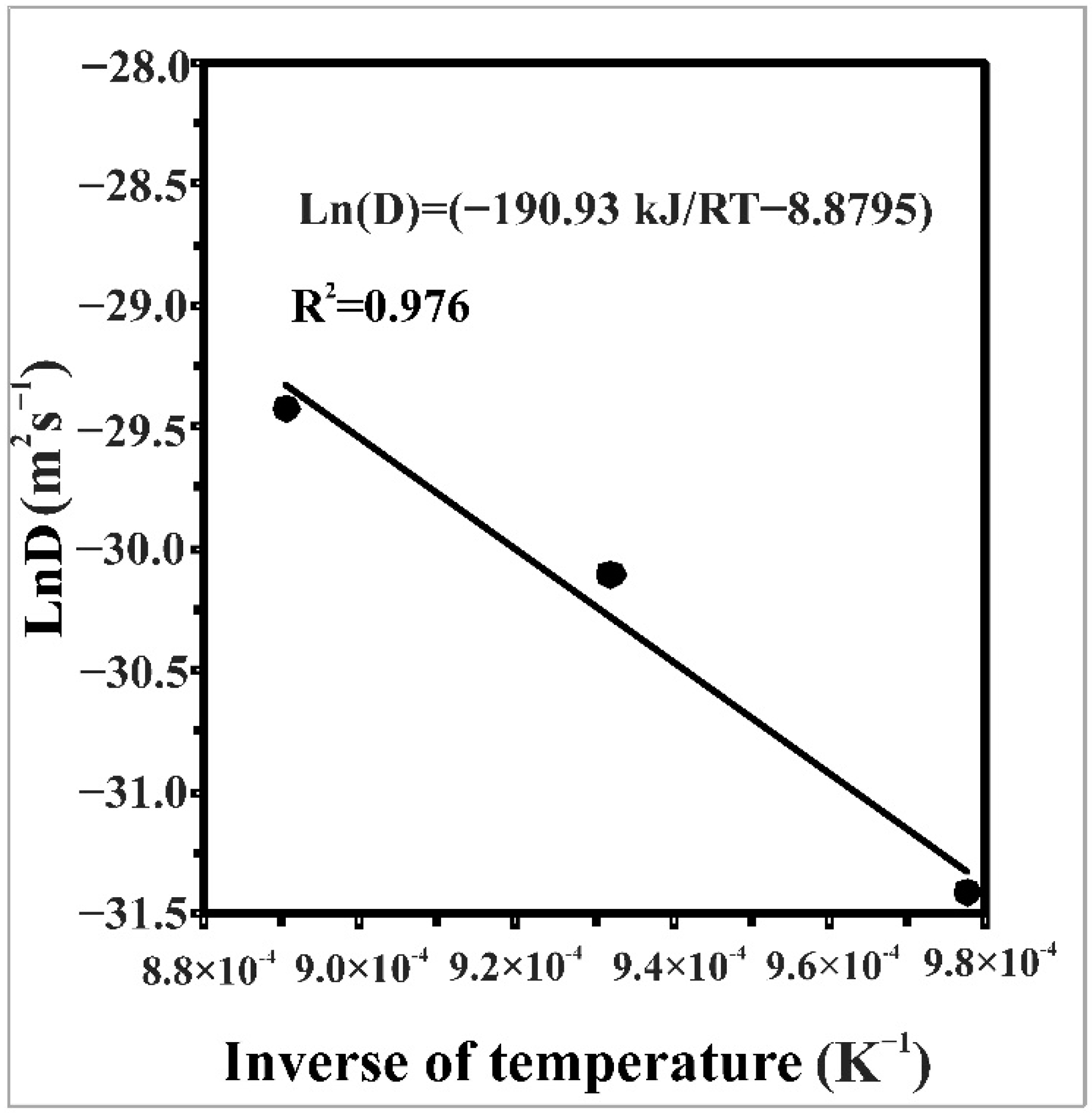Growth Kinetics and Some Mechanical Properties of Plasma Paste Borided Layers Produced on Nimonic 80A-Alloy
Abstract
:1. Introduction
2. Materials and Methods
2.1. Material and Specimens’ Preparation
2.2. Plasma Paste Boriding
2.3. Microstructure and Properties Characterization
3. Results and Discussion
3.1. Microstructure of Boride Layers
3.2. Diffusion Model
3.2.1. The Integral Diffusion Model
3.2.2. Calculation of Boron Diffusion Coefficients through the Entire Boride Layer
3.2.3. Comparison of Boron Activation Energy with the Literature Results
3.2.4. Prediction of Entire Boride Layer Thickness Using the Numerical Solution of DAE System
3.3. Microhardness Profiles
3.4. Cohesion
3.5. Wear Resistance
4. Summary and Conclusions
- The increased processing temperature and longer processing duration ensured the production of thicker borided layers;
- All the produced layers consisted of a mixture of nickel borides and chromium borides;
- The quantity and intensity of the peaks corresponding to chromium borides (CrB or Cr2B) increased at elevated boriding temperature;
- The theoretical thicknesses of the borided layers were estimated using an integral diffusion model. A good correlation was obtained between the theoretical (modeled) and experimental depths of the plasma paste borided layers;
- The estimated value of boron activation energy was found to be equal to 188 ± 14.4 kJ·mol−1. This value was in line with the data of other papers which considered the growth kinetics of the total boride layers, containing the mixture of borides;
- The produced layers were characterized by high hardness ranging from 1160 HV to 2132 HV. It resulted from the multiphase character of the produced layers, which contained a mixture of various nickel borides and chromium borides of different hardness;
- The cohesion of produced boride layers into the substrate material can be classified as a sufficient, corresponding to the HF3 quality map;
- The analysis of mass wear intensity factors indicated the improved wear resistance of the plasma paste borided sample (Imw = 1.47 mg/cm2) in comparison to the non-borided sample (Imw = 9.06 mg/cm2). A significant reduction in the relative mass loss Δm/mi of the plasma paste borided Nimonic 80A-alloy was also demonstrated.
Author Contributions
Funding
Institutional Review Board Statement
Informed Consent Statement
Data Availability Statement
Acknowledgments
Conflicts of Interest
References
- Yoon, J.H.; Jee, Y.K.; Lee, S.Y. Plasma paste boronizing treatment of the stainless steel AISI 304. Surf. Coat. Technol. 1999, 112, 71–75. [Google Scholar] [CrossRef]
- Gunes, I.; Ulker, S.; Taktak, S. Plasma paste boronizing of AISI 8620, 52100 and 440C steels. Mater. Des. 2011, 32, 2380–2386. [Google Scholar] [CrossRef]
- Nam, K.-S.; Lee, K.-H.; Lee, D.Y.; Song, Y.-S. Metal surface modification by plasma boronizing in a two-temperature-stage process. Surf. Coat. Technol. 2005, 197, 51–55. [Google Scholar] [CrossRef]
- Filep, E.; Farkas, S. Kinetics of plasma-assisted boriding. Surf. Coat. Technol. 2005, 199, 1–6. [Google Scholar] [CrossRef]
- Rie, K.-T. Recent advances in plasma diffusion processes. Surf. Coat. Technol. 1999, 112, 56–62. [Google Scholar] [CrossRef]
- Rodriguez Cabeo, E.; Laudien, G.; Biemer, S.; Rie, K.-T.; Hoppe, S. Plasma-assisted boriding of industrial components in a pulsed d.c. glow discharge. Surf. Coat. Technol. 1999, 116, 229–233. [Google Scholar] [CrossRef]
- Scheuer, C.J.; Cardoso, R.P.; Brunatto, S.F. Low-temperature plasma assisted thermochemical treatments of AISI 420 steel: Comparative study of obtained layers. Mater. Res. 2015, 18, 1392–1399. [Google Scholar] [CrossRef] [Green Version]
- Kaestner, P.; Olfe, J.; Rie, K.-T. Plasma-assisted boriding of pure titanium and TiAl6V4. Surf. Coat. Technol. 2001, 142, 248–252. [Google Scholar] [CrossRef]
- Ataibis, V.; Taktak, S. Characteristics and growth kinetics of plasma paste borided Cp–Ti and Ti6Al4V alloy. Surf. Coat. Technol. 2015, 279, 65–71. [Google Scholar] [CrossRef]
- Belkin, P.N.; Kusmanov, S.A. Plasma electrolytic boriding of steels and titanium alloys. Surf. Eng. Appl. Electrochem. 2019, 55, 1–30. [Google Scholar] [CrossRef]
- Qin, L.; Liu, C.; Yang, K.; Tang, B. Characteristics and wear performance of borided Ti6Al4V alloy prepared by double glow plasma surface alloying. Surf. Coat. Technol. 2013, 225, 92–96. [Google Scholar] [CrossRef]
- Keddam, M.; Taktak, S. Characterization and diffusion model for the titanium boride layers formed on the Ti6Al4V alloy by plasma paste boriding. Appl. Surf. Sci. 2017, 399, 229–236. [Google Scholar] [CrossRef]
- Makuch, N.; Kulka, M.; Keddam, M.; Taktak, S.; Ataibis, V.; Dziarski, P. Growth kinetics and some mechanical properties of two-phase boride layers produced on commercially pure titanium during plasma paste boriding. Thin Solid Films 2017, 626, 25–37. [Google Scholar] [CrossRef]
- Makuch, N.; Kulka, M.; Dziarski, P.; Taktak, S. The influence of chemical composition of Ni-based alloys on microstructure and mechanical properties of plasma paste borided layers. Surf. Coat. Technol. 2019, 367, 187–202. [Google Scholar] [CrossRef]
- Makuch, N. The importance of phase composition for corrosion resistance of borided layers produced on nickel alloys. Materials 2020, 13, 5131. [Google Scholar] [CrossRef]
- Qin, L.; Yang, K.; Liu, C.; Tang, B. Enhanced plasma boriding with molybdenum using double glow plasma surface alloying technique. Mater. Lett. 2012, 82, 127–129. [Google Scholar] [CrossRef]
- Johnston, J.M.; Jubinsky, M.; Catledge, S.A. Plasma boriding of a cobalt–chromium alloy as an interlayer for nanostructured diamond growth. Appl. Surf. Sci. 2015, 328, 133–139. [Google Scholar] [CrossRef]
- Verein Deutscher Ingenieure Normen; VDI 3198 VDI Verlag: Berlin, Germany, 1991.
- Taktak, S. Some mechanical properties of borided AISI H13 and 304 steels. Mater. Des. 2007, 28, 1836–1843. [Google Scholar] [CrossRef]
- Kayali, Y.; Günes, I.; Ulu, S. Diffusion kinetics of borided AISI 52100 and AISI 440C steels. Vacuum 2012, 86, 1428–1434. [Google Scholar] [CrossRef]
- Kayali, Y.; Taktak, S. Characterization and Rockwell-C adhesion properties of chromium-based borided steels. J. Adhes. Sci. Technol. 2015, 29, 2065–2075. [Google Scholar] [CrossRef]
- Taktak, S. A study on the diffusion kinetics of borides on boronizedCr-based steel. J. Mater. Sci. 2006, 41, 7590–7596. [Google Scholar] [CrossRef]
- Keddam, M.; Ortiz-Dominguez, M.; Elias-Espinosa, M.; Arenas-flores, A.; Zuno-Silva, J.; Zamarripa–Zepeda, D.; Gomez-Vargas, O.A. Kinetic investigation and wear properties of Fe2B layers on AISI 12L14 steel. Metall. Mater. Trans. A 2018, 49, 1895–1907. [Google Scholar] [CrossRef]
- Yu, L.G.; Chen, X.J.; Khor, K.A.; Sundararajan, G. FeB/Fe2B phase transformation during SPS pack-boriding: Boride layer growth kinetics. Acta Mater. 2005, 53, 2361–2368. [Google Scholar] [CrossRef]
- Predel, B. B-Ni (Boron-Nickel). In Landolt-Börnstein-Group IV Physical Chemistry; Springer: Berlin/Heidelberg, Germany, 2012; p. 61. [Google Scholar]
- Goodman, T.R. Application of integral methods to transient nonlinear heat transfer. Adv. Heat Transf. 1964, 1, 51–122. [Google Scholar]
- Ascher, U.; Petzold, L. Computer Methods for Ordinary Differential Equations and Differential-Algebraic Equations; SIAM: Philadelphia, PA, USA, 1998. [Google Scholar]
- Calik, A.; Ucar, N.; Denikanli, K.; Carkci, M.; Karakas, S. Boriding kinetics and mechanical properties of borided commercial-purity nickel. Indian J. Eng. Mater. Sci. 2017, 24, 362–368. [Google Scholar]
- Gunes, I.; Keddam, M.; Chegroune, R.; Ozcatal, M. Growth kinetics of boride layers formed on 99.0% purity nickel. Bull. Mater. Sci. 2015, 38, 1113–1118. [Google Scholar] [CrossRef]
- Kahvecioglu, O.; Sista, V.; Eryilmaz, O.L.; Erdemir, A.; Timur, S. Ultra-fast boriding of nickel aluminide. Thin Solid Films 2011, 520, 1575–1581. [Google Scholar] [CrossRef]
- Torun, O. Boriding of nickel aluminide. Surf. Coat. Technol. 2008, 202, 3549–3554. [Google Scholar] [CrossRef]
- Contla-Pacheco, A.D.; Keddam, M.; Lartundo-Rojas, L.; Ortega-Aviles, M.; Mejía-Caballero, I.; Campos-Silva, I. Application of the Heat Balance Integral Method to the growth kinetics of nickel boride layers on an Inconel 718 superalloy. Surf. Coat. Technol. 2021, 420, 127355. [Google Scholar] [CrossRef]
- Makuch, N. Nanomechanical properties and fracture toughness of hard ceramic layer produced by gas boriding of Inconel 600 alloy. Trans. Nonferrous Met. Soc. China 2020, 30, 428–448. [Google Scholar] [CrossRef]
- Makuch, N.; Kulka, M.; Piasecki, A. The effects of chemical composition of Nimonic 80A-alloy on the microstructure and properties of gas-buried layer. Surf. Coat. Technol. 2015, 276, 440–455. [Google Scholar] [CrossRef]
- Kulka, M.; Makuch, N.; Dziarski, P.; Piasecki, A. A study of nanoindentation for mechanical characterization of chromium and nickel borides′ mixtures formed by laser boriding. Ceram. Int. 2014, 40, 6083–6094. [Google Scholar] [CrossRef]
- Makuch, N.; Piasecki, A.; Dziarski, P.; Kulka, M. Influence of laser alloying with boron and niobium on microstructure and properties of Nimonic 80A-alloy. Opt. Laser Technol. 2015, 75, 229–239. [Google Scholar] [CrossRef]








| Temperature (K) | k (µm s−0.5) at the Entire Boride Layer/Substrate Interface |
|---|---|
| 1023 | 0.1987 |
| 1073 | 0.3825 |
| 1123 | 0.5376 |
| Temperature (K) | D (×10−14 m2/s) |
|---|---|
| 1023 | 2.27 |
| 1073 | 8.41 |
| 1123 | 16.62 |
| Material | Boriding Technique | Temperature Range (K) | Phases Present in the Boride Layer | Boron Activation Energy (Kj·Mol−1) | Calculation Method | Refs. |
|---|---|---|---|---|---|---|
| Pure Ni | Powder-pack boriding (Ekabor II) | 1123–1273 | Ni2B, Ni6Si2B | 47.3 | Parabolic growth law | [28] |
| Nickel 201 | Powder-pack boriding (B4C + KBF4) | 1123–1273 | NiB, Ni2B, Ni3B, Ni4B3 | 203.87 | Parabolic growth law | [29] |
| Ni3Al | Electrochemical boriding | 1073–1223 | Ni3B, Ni4B3, Ni20AlB14 | 185.95 | Parabolic growth law | [30] |
| Ni3Al | Powder-pack boriding (Ekabor-Ni) | 1073–1223 | Ni3B, Ni4B3, Ni3Al | 188 ± 14.4 | Parabolic growth law | [31] |
| Inconel 718 | Powder-pack boriding (90% B4C + 10% KBF4) | 1123–1223 | Ni4B3, Ni2B, Ni3B, Fe2B, Cr2B | 233.20 (Ni4B3) 206.17 (Ni2B) 218.06 (Ni3B) | Integral diffusion model | [32] |
| Nimonic 80A | Plasma paste boriding | 1023–1123 | NiB, Ni2B, Ni3B, Ni4B3 | 190.93 | Integral diffusion model | [The present work] |
| Temperature (K) | Time (h) | Experimental Layer Thickness (µm) | Standard Deviation (mm) | Predicted Layer Thickness (µm) |
|---|---|---|---|---|
| 1023 | 0 | 0 | 0 | 0 |
| 3 | 19.06 | 0.67 | 21.58 | |
| 4 | 25.06 | 0.61 | 24.92 | |
| 6 | 29.34 | 1.73 | 30.52 | |
| 1073 | 0 | 0 | 0 | 0 |
| 3 | 40.23 | 0.82 | 36.41 | |
| 4 | 44.56 | 1.28 | 42.04 | |
| 6 | 56.97 | 2.3 | 51.49 | |
| 1123 | 0 | 0 | 0 | 0 |
| 3 | 55.81 | 0.85 | 58.63 | |
| 4 | 66.04 | 1.28 | 67.7 | |
| 6 | 77.82 | 3.09 | 82.93 |
Publisher’s Note: MDPI stays neutral with regard to jurisdictional claims in published maps and institutional affiliations. |
© 2021 by the authors. Licensee MDPI, Basel, Switzerland. This article is an open access article distributed under the terms and conditions of the Creative Commons Attribution (CC BY) license (https://creativecommons.org/licenses/by/4.0/).
Share and Cite
Makuch, N.; Dziarski, P.; Kulka, M.; Keddam, M. Growth Kinetics and Some Mechanical Properties of Plasma Paste Borided Layers Produced on Nimonic 80A-Alloy. Materials 2021, 14, 5146. https://doi.org/10.3390/ma14185146
Makuch N, Dziarski P, Kulka M, Keddam M. Growth Kinetics and Some Mechanical Properties of Plasma Paste Borided Layers Produced on Nimonic 80A-Alloy. Materials. 2021; 14(18):5146. https://doi.org/10.3390/ma14185146
Chicago/Turabian StyleMakuch, Natalia, Piotr Dziarski, Michał Kulka, and Mourad Keddam. 2021. "Growth Kinetics and Some Mechanical Properties of Plasma Paste Borided Layers Produced on Nimonic 80A-Alloy" Materials 14, no. 18: 5146. https://doi.org/10.3390/ma14185146
APA StyleMakuch, N., Dziarski, P., Kulka, M., & Keddam, M. (2021). Growth Kinetics and Some Mechanical Properties of Plasma Paste Borided Layers Produced on Nimonic 80A-Alloy. Materials, 14(18), 5146. https://doi.org/10.3390/ma14185146






